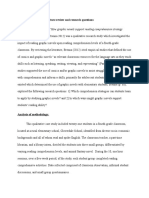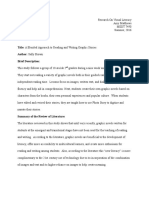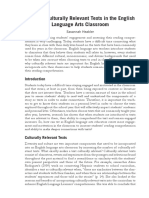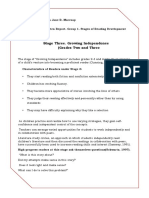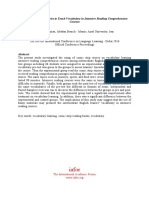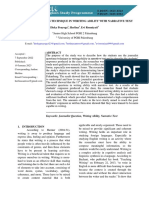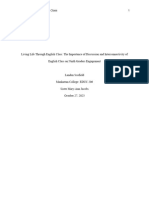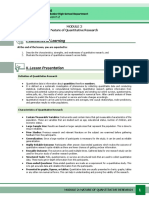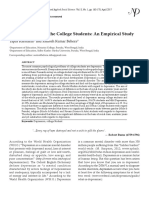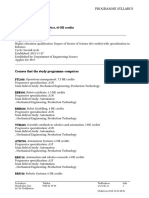Running Header: Graphic Novels To Build Comprehension
Running Header: Graphic Novels To Build Comprehension
Uploaded by
api-288613356Copyright:
Available Formats
Running Header: Graphic Novels To Build Comprehension
Running Header: Graphic Novels To Build Comprehension
Uploaded by
api-288613356Original Title
Copyright
Available Formats
Share this document
Did you find this document useful?
Is this content inappropriate?
Copyright:
Available Formats
Running Header: Graphic Novels To Build Comprehension
Running Header: Graphic Novels To Build Comprehension
Uploaded by
api-288613356Copyright:
Available Formats
Running Header: GRAPHIC NOVELS TO BUILD COMPREHENSION
Graphic Novels and Comic Books Used in Elementary School to Build Comprehension
Jennifer Stone
University of West Georgia
GRAPHIC NOVELS TO BUILD COMPREHENSION
Title of Article
How Graphic Novels Support Reading Comprehension Strategy Development in Children
Author
Beverley Brenna
Summary of Literature
The study took place at Cloverdale School over a period of 5 weeks that lasted ten hours
in a 4th grade classroom. Beverley was using graphic novels with the students to see if they
comprehended not just the words but also the meaning of pictures because, images is as
important as comprehensive decoding of, and personal response to, written language (Brenna,
B., p. 89).
Analysis of Methodology
The method of analysis was a qualitative case study of fourth grade students and how the
students used reading comprehension strategies while utilizing graphic novels in the classroom.
Research Findings
The research findings stated that further research needed to be conducted on the subject
matter because more questions emerged during their study. The idea of utilizing graphic novels
in the classroom for comprehension is an unexplored area and needs more exploration. The
findings demonstrated that graphic novels appear to offer richness in terms of a context for
teaching reading comprehension (Brenna, B., p. 93).
Opinion about the Research
My opinion about the research is that its realistic to what actually takes place in the
classroom because Beverley had a group of students during the study to evaluate. She interacted
with the 4th graders, listened to them read, and asked them questions about the graphic novels.
GRAPHIC NOVELS TO BUILD COMPREHENSION
What did I learn?
I learned from the study that pictures are just as powerful as words when it comes to
comprehension. Students may not immediately want to pick up a graphic novel to read but with
exposure students may gravitate toward the graphic novels more and their reading
comprehension may soar. Theres a quote I enjoyed reading and I may place it on my classroom
wall this school year, English Language Arts teaching goals involved supporting the
development of reading strategies and reading for pleasure (Brenna. B., p. 89).
Reference
Brenna, B. (2013). How graphic novels support reading comprehension strategy development in
children. Literacy, 47(2), 88-94.
GRAPHIC NOVELS TO BUILD COMPREHENSION
Title of Article
The Effect of Comic Books on Vocabulary Growth and Reading Comprehension
Authors
Edith Z. Sperzel
Summary of Literature
The author wanted to know if the current trend of comic books could be put into the
classroom in the area of vocabulary and reading comprehension. The author of the case study
was able to contact Marvel, Disney, and DC distributors for samples for forty-five students.
There were three groups of students and within each group were fifteen, fifth graders.
Analysis of Methodology
The methodology used was a control group (Group I) and two experimental groups
(Group II and Group III). The groups were formed by I.Q., ability, and social-economic status.
Each group was also given the Gates Reading Survey Test for Vocabulary and Reading at the
beginning and at the end of the case study. Control Group I went through their normal reading
class. Group II and III (experimental groups) read comic books for thirty minutes each day for
six weeks. The difference between Group II and Group III was that Group III was asked to keep
a word list of words that were difficult and words they enjoyed. Group II didnt meet with the
teacher but they read as many books as they pleased as where Group III met with the teacher to
talk about their word list.
Research Findings
The students were given the Gates Reading Survey Test for Vocabulary and Reading at
the end of the six weeks to check for growth. According to the data, Group II showed the
greatest gain in comprehension with a raw score of 3.8. The control group was second with a
GRAPHIC NOVELS TO BUILD COMPREHENSION
raw score of 2.3. As for vocabulary growth, the greatest gain was Group III with a raw score of
3.1. The control group was next with a raw score of 2.3. The first research finding the author
pointed out was how respectful the student were during the students independent comic books
reading time. She mentioned how the students would tip toe around the room to not bother one
another.
Opinion about the Research
Theres some information I would like to know about the groups thats missing from this
case study, such as, which group represented the high, middle, and low social economical class?
Im trying to understand the numbers because some of them are not making sense. I was
surprised to see that someone had written an article in 1948 about comics being used in the
classroom but its difficult to locate a recently written today correlated to comprehension.
What did I learn?
I learned that meeting with a group of student about vocabulary they find interesting but
also difficult would increase their understanding of words. I dont understand how Group II was
able to score higher on comprehension than Group III. Only Group III met with the teacher and
discussed the meaning of words that would help build comprehension of the book unless Group
II was the higher social economic class student. I also recall previous research that stated the
amount of time we give students to read helps increase comprehension. Students need more than
thirty minutes of reading time to comprehend and make meaning out of text.
Reference
Sperzel, E. Z. (1948). The Effect of comic books on vocabulary growth and reading
comprehension. Elementary English, 25(2), 109-113.
GRAPHIC NOVELS TO BUILD COMPREHENSION
Title of Article
Pupils Use of Time While Reading Comics and Books
Authors
Marshall Arlin and Garry Roth
Summary of Literature
The case study took place in two 3rd grade classrooms in Canada over a period of 10
weeks with 42 children. They were assigned to choose either a comic book or a regular book to
read during free reading time that lasted 20 minutes a day. The study was looking at time-ontask and time-on-reading of comic books and regular books.
Analysis of Methodology
The authors of this case study used different types of methodology such as hypothesis
they didnt consider to be researched based but they felt that the pictures from the comics would
speak volumes. They wanted to see if there was a correlation between time-on-task and time-onreading with comprehension using comic books and regular books students read every day.
They looked at student eye movement, lip movement as well when they were reading, positive
attitude, and where they started in the comic/book when they read.
Research Findings
The findings focused on comic and it was stated that time-on-task wasnt the issue it was
time-on-reading because, Readers are apparently distracted from the words by the pictures and
consequently spend less time on words and sentences (Arlin, M., Roth. G., p. 211). The case
study related time-on-task and time-on-reading to higher comprehension gains, comics result in
less reading comprehension gain than books for poor readers (Arlin, M., Roth. G., p. 211).
GRAPHIC NOVELS TO BUILD COMPREHENSION
Opinion about the Research
The research has pointed out that time-on-task and time-on-reading is correlated to
comprehension. Higher level reading ability students spent the same amount of time reading a
comic book as they did a regular book and comprehended the same amount of information. As
for the lower level performing students spent more time on the time-on-task but less time on the
time-on-reading resulting on less comprehension. Near the end of the case study the two
professors mention McGraw-Hill created comic book versions to motivate low-level readers
which would include vocabulary builders, comprehension checks, filmstrips with sound, and
time-on-reading (Arlin, M., Roth. G., p. 212).
What did I learn?
This case study took place in 1978 however I feel its the same idea that students must
stay focused in order to read and comprehend. I dont agree that students cant do that with
comic books because teaching has come a long way since 1978 and we build a lot of background
knowledge and vocabulary skills for students so they are able to understand what they are
reading. I disagree with what the authors were saying, When reading comics, reading ability is
related to amount of time spent attending to words, which is in turn related to comprehension
gains; consequently poor readers will be at a disadvantage when reading comics. (Arlin, M.,
Roth. G., p. 211) The reason I disagree with this statement is because the reason the children
dont comprehend the words is due to the rich vocabulary. Once the students understand the
vocabulary they would be able to comprehend what was happening in the story that is written
and drawn in the book. Its just a matter of building a students vocabulary and finding what
sparks the students interest.
GRAPHIC NOVELS TO BUILD COMPREHENSION
Reference:
Arlin, M., & Roth, G. (1978). Pupils use of time while reading comics and books. American
Educational Research Journal, 15(2), 201-216.
GRAPHIC NOVELS TO BUILD COMPREHENSION
Title of Article
The Use of English Comic Book Series in Teaching Reading Comprehension
Authors
Windo Apriani, Machdalena Vianty, and Banbang A.L.
Summary of Literature
There were two classes of seventh grade boys in Indonesia. One group would be the
control group and the other group would be the experimental group who would learn English
utilizing American comic books. Their English teacher would spend 20 sessions with the
experimental group while the control group was exposed to the traditional reading course book.
Analysis of Methodology
The Quasi-Experimental methodology was used during this case study as were pre-test
and post-test, and a reading test. The author had a control group and an experimental group that
she was working with during the case study. Variables were the English Comic Book
(Independent variable) and the Reading Comprehension of SMP Negeri (Dependent Variable).
The author also used t-test for both groups.
Research Findings
Research findings showed the control group who were not exposed to the English Comic
book series didnt show as much growth in reading comprehension as those who were in the
experimental group. In the area of vocabulary, the experimental group scored a 5 on the pre-test
and 10 on the post-test and the control group scored a 7 on both the pre-test and post-test. In the
area of comprehension, experimental scores 63 on pre-test and an 86 on the post-test. The
control group scored a 66 on the pre-test and 79 on the post-test on comprehension.
GRAPHIC NOVELS TO BUILD COMPREHENSION
10
Opinion about the Research
The research has shown from the experimental and control groups that text does matter to
students when they read. Theres a question as to whether the other teacher was as involved or
entertaining as the one teaching the comic book series but that wasnt in the case study. The data
has shown that student vocabulary grew as well as their comprehension.
What did I learn?
Even though this case study was conducted with students in seventh grade I feel it can be
applied to elementary students because parents and administrators will complain that students
will not understand the meaning of words or that theres too much happening on a page for
comprehension to take place. Visual literacy is important for meaning to take place no matter
what part of the country an individual lives
Reference
Apriani, W., Vianty, M., & Loeneto, B. A. (2015). The Use Of English Comic Book
Series In Teaching Reading Comprehension. Journal of English Literacy Education, 1(2),
100-105.
GRAPHIC NOVELS TO BUILD COMPREHENSION
11
Title of Article
Graphic Novels: What Elementary Teachers Think About Their Instructional Value
Authors
Diane Lapp, Thomas Devere Wolsey, Douglas Fisher, and Nancy Frey
Summary of Literature
The authors wanted to find out how teachers used graphic novels in their classroom and
their attitude toward graphic novels. One summer during and a summer institute, the authors
worked with sixty graduate students at a conference. These graduate students from different
areas of education participated in a survey on their attitude and integration of graphic novels.
Analysis of Methodology
The methodology was quantitative interest/attitudinal survey, (Liker-type scale) created
by the authors, about graphic novels in the classroom. The authors wanted to know how
teachers felt about comics being used, using them as writing tools, strategies for lower level
learners, and how they are or would use graphic novels in their classrooms. The authors defined
the words comic and graphic novel to the participants for the survey.
Research Findings
Research findings showed teacher attitudes were positive however in grade third through
eighth teachers were not utilizing graphic novels except once a year. Teachers saw a need for
graphic novels for lower level students and English as a second language student. They also
didnt have the resources needed to implement graphic novels into their classroom. As the
author stated, the lack of use is due to lack of availability or the culture of constrictive
accountability that may be an equally plausible reason for the discrepancy between teacher
interest and curricular implementation. (Lapp, D., Wolsey, Fisher, Frey, p. 31)
GRAPHIC NOVELS TO BUILD COMPREHENSION
12
Opinion about the Research
The survey that was conducted showed that teachers say they integrate graphic novels in
the classroom but when questions are asked several different ways the data shows that in
actuality graphic novel integration only happens when its convenient. As the authors of the
article stated, Without access to graphica in sufficient quantities to match the needs and reading
preferences of students, it would be difficult for teachers to use the genre in their classrooms (p.
31).
What did I learn?
I learned that Im not the only one who didnt read comics growing up. Its nice to read a
realistic article where data shows that teachers want to do their job but due to budget restrictions
and mandated testing teachers are unable to meet the needs of the students. I also learned that
teachers dont see graphic novels as a way to enrich students who are higher leveled readers.
This was new information while reading the article because I thought students creating their own
graphic novels would be a higher level thinking skill.
Reference
Lapp, D., Wolsey, T. D., Fisher, D., & Frey, N. (2011). Graphic novels: What elementary
teachers think about their instructional value. Journal of Education, 23-35.
You might also like
- Learning From Graphic Novels 1Document10 pagesLearning From Graphic Novels 1api-660972274No ratings yet
- Jac Harris Assignment 7 Article 1 SummaryDocument3 pagesJac Harris Assignment 7 Article 1 Summaryapi-335579446No ratings yet
- Are Comics Effective Materials For Teaching EllsDocument12 pagesAre Comics Effective Materials For Teaching Ellsjavier_meaNo ratings yet
- Assignment 5 Using Graphic NovelsDocument11 pagesAssignment 5 Using Graphic Novelsapi-307744722No ratings yet
- Research On Visual LiteracyDocument9 pagesResearch On Visual Literacyapi-323984747No ratings yet
- 303 Final PortfolioDocument9 pages303 Final PortfolioMaddie WilsonNo ratings yet
- National Council of Teachers of EnglishDocument9 pagesNational Council of Teachers of EnglishemysamehNo ratings yet
- Framing 6 English Language Arts VDocument21 pagesFraming 6 English Language Arts Vapi-666221151No ratings yet
- 7490 Assignment6 AhwDocument6 pages7490 Assignment6 Ahwapi-284171435No ratings yet
- Balancing Literature in The Classroom FinalDocument16 pagesBalancing Literature in The Classroom Finalapi-259774494No ratings yet
- RUNNING HEAD: Statement On DevelopmentDocument20 pagesRUNNING HEAD: Statement On Developmentapi-434818140No ratings yet
- Final La Unit PlanDocument17 pagesFinal La Unit Planapi-373133787No ratings yet
- Jigsaw 2Document17 pagesJigsaw 2Muhammad Fuad MahfudNo ratings yet
- Polizzi - Action Research ProjectDocument21 pagesPolizzi - Action Research Projectapi-322025855No ratings yet
- Communicating With Text As A Teaching Strategy To Write A Preliminary Lterature ReviewDocument31 pagesCommunicating With Text As A Teaching Strategy To Write A Preliminary Lterature Reviewwuri2008100% (1)
- HeablerDocument5 pagesHeablerMaria Ronalyn Deguinion AcangNo ratings yet
- Teaching With ComicsDocument9 pagesTeaching With Comicsapi-290407034No ratings yet
- Language Arts Literacy 5 FinalDocument11 pagesLanguage Arts Literacy 5 Finalapi-346891460No ratings yet
- Stage Three. Growing Independence (Grades Two and ThreeDocument5 pagesStage Three. Growing Independence (Grades Two and ThreeMa. Victoria RamosNo ratings yet
- Action Report Research PaperDocument6 pagesAction Report Research Paperapi-710156794No ratings yet
- Children'S Literature: Readers Are Made, Not Born Literature Is More Experienced Than TaughtDocument11 pagesChildren'S Literature: Readers Are Made, Not Born Literature Is More Experienced Than TaughtimqisyaNo ratings yet
- On The Outside Looking In: A Study of Remedial Readers' Meaning-Making While Reading LiteratureDocument19 pagesOn The Outside Looking In: A Study of Remedial Readers' Meaning-Making While Reading LiteratureJan Michael FloreceNo ratings yet
- Diversity Reflection: Library Lady, Solidified The Students' Ability To Make Connections To The Story. The Play WasDocument1 pageDiversity Reflection: Library Lady, Solidified The Students' Ability To Make Connections To The Story. The Play WasanynaoNo ratings yet
- Teaching LiteratureDocument11 pagesTeaching Literaturesha100% (2)
- Using Comic Strip Stories To Teach Vocabulary in Intensive Reading ComprehensionDocument12 pagesUsing Comic Strip Stories To Teach Vocabulary in Intensive Reading ComprehensionSandy RodriguezNo ratings yet
- Edla430 Assignment 3 Terina MacareDocument26 pagesEdla430 Assignment 3 Terina Macareapi-266593657No ratings yet
- Claim: As A Literacy Leader, I Design Authentic Literacy ExperiencesDocument8 pagesClaim: As A Literacy Leader, I Design Authentic Literacy ExperiencesreyNo ratings yet
- Running Head: Image Use in History 0Document10 pagesRunning Head: Image Use in History 0api-322595193No ratings yet
- RUNNING HEAD: Literature ProjectDocument11 pagesRUNNING HEAD: Literature Projectapi-434818140No ratings yet
- Research PaperDocument15 pagesResearch Paperapi-518644243No ratings yet
- Evaluating Childrens LiteratureDocument5 pagesEvaluating Childrens Literatureapi-296864651No ratings yet
- Teaching Reading Narrative Reading by Using Literature Circles Strategy To The Tenth Grade Students of Sman 1 Lempuing Jaya NofitarinaDocument15 pagesTeaching Reading Narrative Reading by Using Literature Circles Strategy To The Tenth Grade Students of Sman 1 Lempuing Jaya NofitarinaKevin RajNo ratings yet
- Introduction ADocument22 pagesIntroduction AMiftahul HudaNo ratings yet
- WRITINGDocument6 pagesWRITINGAdnin ajaNo ratings yet
- Assignment 7 Teaching Vocabulary Using ComicsDocument6 pagesAssignment 7 Teaching Vocabulary Using Comicsapi-324734668No ratings yet
- Thesis Tentang Reading ComprehensionDocument6 pagesThesis Tentang Reading Comprehensiongjbyse71100% (2)
- Authentic News Item Text For Improving Students' Ability in Finding Main IdeaDocument10 pagesAuthentic News Item Text For Improving Students' Ability in Finding Main IdeaMuh Abid ArrohmanNo ratings yet
- Literature FrameworkDocument6 pagesLiterature Frameworkapi-516460644No ratings yet
- Example of Paper of TextbookDocument10 pagesExample of Paper of TextbookTea PotNo ratings yet
- Action ResearchDocument50 pagesAction ResearchYamunaa SivalingamNo ratings yet
- Read-Alouds AssignmentDocument6 pagesRead-Alouds Assignmentapi-349873749No ratings yet
- Literature Circles: Acquiring Language Through CollaborationDocument13 pagesLiterature Circles: Acquiring Language Through CollaborationkevinmmaherNo ratings yet
- Research ArticleDocument10 pagesResearch Articleapi-710022904No ratings yet
- Literacy Module 5 OgdimalantaDocument6 pagesLiteracy Module 5 OgdimalantaSunshine ArceoNo ratings yet
- READINGDocument8 pagesREADINGArmina GuiamalonNo ratings yet
- Educ 376 - Action Research - Signature Pedagogy 6Document11 pagesEduc 376 - Action Research - Signature Pedagogy 6api-644943881No ratings yet
- Educ 376 - Action Research 2Document14 pagesEduc 376 - Action Research 2api-584003666No ratings yet
- Vocabulary Ideas Compiled by DebDocument30 pagesVocabulary Ideas Compiled by DebRiki Ari Andri YaniNo ratings yet
- Guiding Response Young To Students Response To LiteratureDocument8 pagesGuiding Response Young To Students Response To LiteratureLindsay BrelsfordNo ratings yet
- MetaphorsDocument8 pagesMetaphorsapi-255672961No ratings yet
- EnglishDocument15 pagesEnglishJemalyn BasulNo ratings yet
- Annotated BibliographiesDocument3 pagesAnnotated Bibliographiesapi-382712444No ratings yet
- Ued495-496 Cordero Jaclyn Content Knowledge Interdisciplinary CurriculumDocument7 pagesUed495-496 Cordero Jaclyn Content Knowledge Interdisciplinary Curriculumapi-401717873No ratings yet
- MegcasDocument37 pagesMegcasMeg StraussNo ratings yet
- Cycle 2-Annotated Bibliography 1Document4 pagesCycle 2-Annotated Bibliography 1api-343815626100% (1)
- Te 848 Teaching Project PaperDocument23 pagesTe 848 Teaching Project Paperapi-287036169No ratings yet
- Lesson Plan For 3 12 19Document5 pagesLesson Plan For 3 12 19api-458750555No ratings yet
- Emerging Readers & Writers Sharing Big BooksDocument3 pagesEmerging Readers & Writers Sharing Big BooksReza RismunandarNo ratings yet
- Annotated Bibliography Template With SampleDocument5 pagesAnnotated Bibliography Template With SampleAlexander G. PoldoNo ratings yet
- Teachers' Outlines for Studies in English Based on the Requirements for Admission to CollegeFrom EverandTeachers' Outlines for Studies in English Based on the Requirements for Admission to CollegeNo ratings yet
- 10.1016@j.actaastro.2022.09.054 Acta Astron The Psychology and Mental Health of The Spaceflight EnvironmentDocument65 pages10.1016@j.actaastro.2022.09.054 Acta Astron The Psychology and Mental Health of The Spaceflight Environmentstephane.chenardNo ratings yet
- Review of Related Literature About Beauty SalonDocument7 pagesReview of Related Literature About Beauty Salonafmzaxfmrdaame100% (1)
- Media ResearchDocument53 pagesMedia Researchdeepak kumarNo ratings yet
- Students Perception and Experience Towards The Quality of OnlineDocument18 pagesStudents Perception and Experience Towards The Quality of OnlineAlyanna De LeonNo ratings yet
- Ethiopian Civil Service University Colle 2Document93 pagesEthiopian Civil Service University Colle 2wendmnehNo ratings yet
- Action Research Preparing The Action Research Proposal Lesson 4 ContinuationDocument62 pagesAction Research Preparing The Action Research Proposal Lesson 4 ContinuationJahara100% (1)
- Ginfed Rum ReportDocument16 pagesGinfed Rum ReportKuntalDekaBaruahNo ratings yet
- Nyemba HRDADocument80 pagesNyemba HRDAditi mNo ratings yet
- Electronic Thesis Addis Ababa UniversityDocument5 pagesElectronic Thesis Addis Ababa Universitybsgnqj4n100% (1)
- The Roleof Knowledge ManagementDocument20 pagesThe Roleof Knowledge ManagementMEHDI JAHANIRADNo ratings yet
- Leader Member Exchange TheoryDocument30 pagesLeader Member Exchange TheoryAbhishek Rana0% (1)
- Research ProposalDocument3 pagesResearch ProposalWasif NibirNo ratings yet
- Ajay R Sop UelDocument3 pagesAjay R Sop UelAmrita Heart CareNo ratings yet
- Module 2 SH 004Document11 pagesModule 2 SH 004vency amandoronNo ratings yet
- Characterizing Hope: An Interdisciplinary Overview of The Characteristics of HopeDocument43 pagesCharacterizing Hope: An Interdisciplinary Overview of The Characteristics of Hopejeanfelix270No ratings yet
- Representations in Problem Solving: A Case Study With Optimization ProblemsDocument30 pagesRepresentations in Problem Solving: A Case Study With Optimization ProblemsIlham 'iam' FauziNo ratings yet
- Ser Caminhoneiro No BrasilDocument14 pagesSer Caminhoneiro No BrasilLuigi Francesco PavanelloNo ratings yet
- Methods of Educational PsychologyDocument4 pagesMethods of Educational PsychologyArun Mahendran50% (2)
- Pre Test in English Grade 9 First QuarterDocument14 pagesPre Test in English Grade 9 First QuarterHenryNo ratings yet
- Measuring Retail Supply Chain Performance - Theoretical Model Using Key Performance Indicators (KPIs)Document34 pagesMeasuring Retail Supply Chain Performance - Theoretical Model Using Key Performance Indicators (KPIs)shradha_DAIMSRNo ratings yet
- Depression Among The College Students AnDocument8 pagesDepression Among The College Students AnArlan MillaNo ratings yet
- Final IMRAD FormatDocument18 pagesFinal IMRAD FormatLyka Bantawig100% (1)
- ARTICLE - Narrative Inquiry As Pedagogy in Education - The Extraordinary Potential of Living, Telling, RetellingDocument32 pagesARTICLE - Narrative Inquiry As Pedagogy in Education - The Extraordinary Potential of Living, Telling, RetellingLuz QuinteroNo ratings yet
- A Project Report On "Study of Training and Development of Employees IN Birla Cement Plant Satna (M.P.) "Document51 pagesA Project Report On "Study of Training and Development of Employees IN Birla Cement Plant Satna (M.P.) "Shivank BaghelNo ratings yet
- Robotics Master Program University VästDocument3 pagesRobotics Master Program University VästAkik BiswasNo ratings yet
- Midterm Exam in Practtical Research 1 For YakalDocument2 pagesMidterm Exam in Practtical Research 1 For YakalAngelGraceVillarinNo ratings yet
- A - Saif Final Project.Document64 pagesA - Saif Final Project.Karun SehgalNo ratings yet
- Factors That Infuence Tourists Decisions To Visit Cltural Heritage Site in Tuguegarao CityDocument45 pagesFactors That Infuence Tourists Decisions To Visit Cltural Heritage Site in Tuguegarao CityinnovativeattendancemonitoringNo ratings yet
- SUCCESS IN THE ENGINEERING PROFESSION EssayDocument6 pagesSUCCESS IN THE ENGINEERING PROFESSION EssayKristinekNo ratings yet
- A Guide To Work-Based Learning Anne RawlingsDocument157 pagesA Guide To Work-Based Learning Anne RawlingsRABIU HARUNA100% (1)

